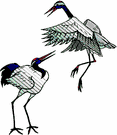A few days I did some birding in the pinyon-juniper habitat around the Royal Gorge (a deep canyon through which the Arkansas River runs just before it gets to Canon City). I saw birds expected in this habitat including 2 Gray Flycatchers. As I drove slowly along a gravel county road looking for birds I spotted the Northern Pygmy-Owl in these pics.

This is the first pygmy-owl I have spotted without benefit of some auditory cues. I have previously spotted Northern Pygmy-Owls that were calling and about 10 years ago I spotted a Ferruginous Pygmy-Owl in Mexico after hearing some land birds fussing near it. The bottom pic is what I saw when I put my binoculars on this owl after spotting it with just with my eyes. It was just under 100 feet from the road in snag branch of a juniper tree.After I shot these pics, the owl opened it's beak and emitted insect-like calls. (
Birds of North America (BNA) online states, "Nestlings and fledglings give Begging Call that sounds insect-like, similar to katydid’s “song”" I also heard the same insect-like call coming from below this owl and then a second Northern Pygmy-Owl flew out from the foliage in the live juniper branches beneath the first owl. Then the first owl flew off. I continued to hear the insect-like calls and was able to follow the owls as they flew from tree to tree. I believe there were at least 3 of these little (they are only about 7 inches tall) owls there.

I believe this owl is in juvenal plumage as it does not have the distinctive spotting on the crown and nape as adults do. Also, the bill is grayish instead of the yellow that BNA and some field guides describe for adults (but some field guides describe other colors so this is not consistent or definitive). I also believe this is probably a fledgling owl because it emitted a call that is given by nestlings and fledglngs (it is not a nestling as it is clearly out of the nest).

Johnsgard, in
North American Owls (2002, p.141) says that, "Northern Pygmy-Owls are "seemingly nonsocial, tending to remain solitary or in highly dispersed pairs (or family groups) through-out the year." So it seems most likely that the 2-3 owls I saw were a family group.BNA states, "Once fledged, young seem to stay close together and one or both parents feed them." So this probable fledgling may have been with one or more siblings and likely a parent. It is possible that their nest site is not far away. Though this species is known to nest in pinyon-juniper habitat as they were found in, there was a nearby ravine with deciduous trees that was likely a riparian area associated with an intermittent stream.
Please note that the middle pic enlarges for a pretty good super close-just double-click on that pic. SeEtta























